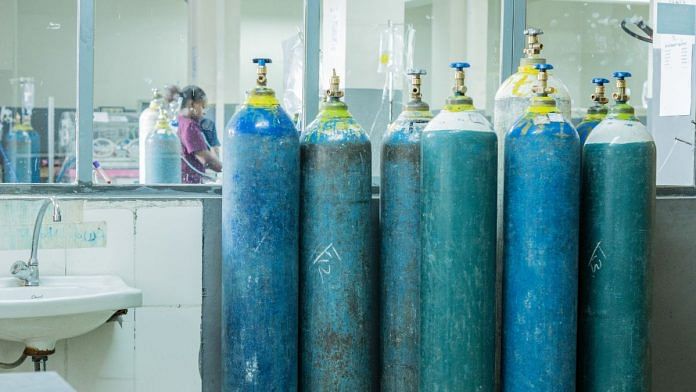New Delhi: Oxygen may be present all around us, but there are currently five billion people around the world who do not have access to safe and affordable medical oxygen. That is 62.5 percent of the world’s total population, and a new study published Tuesday in the journal Lancet Global Health documents exactly how they are deprived.
The life-giving gas is an essential medicine and necessary in surgeries, but there is huge inequality in its distribution. In the new study, the Lancet Global Health Commission outlined for the first time ever the kind of investment needed to fill the medical oxygen access gap in the world.
The study found that globally, 374 million people need medical oxygen every year, most of which is for surgical operations. Of these, 306 million live in low- and middle-income countries (LMICs), which restricts their access to good quality oxygen. Only 30 percent of people in LMICs are able to meet their surgical oxygen requirements, leaving the remaining 70 percent vulnerable—sometimes even fatally.
Even within LMICs, South Asia was found to be the second worst-hit region for oxygen access. Of 32 million people who annually need oxygen in the region, only 22 percent get it. The worst-hit region is sub-saharan Africa where nine percent have access to medical oxygen, and the best is eastern Europe, where 48 percent have access.
This immense oxygen gap in the world is because of a few broad reasons—the lack of oxygen services in medical facilities, the inability to identify oxygen needs due to poor pulse oximetry testing, and high oxygen costs for patients. As part of the study, the Lancet team estimated the amount of investment that would be needed to bridge this gap.
Around $6.8 billion is required annually until 2030 to provide equitable access to medical oxygen in LMICs. The study calculated how cost effective investment in medical oxygen is, comparing it to childhood immunisations in terms of the median cost per disability-adjusted life year (DALY). This means that it costs an investment of around $64 in oxygen therapy to save one year’s worth of healthy human life.
“Therefore, there should be no question as to whether investment in oxygen-system strengthening is value for money,” reads the report.
Also Read: Search for an Indian Carl Sagan is on. Science influencers are being trained in labs and likes
Long-term oxygen issues
Despite being used in surgery and medicine since at least 1885, oxygen was only added to the World Health Organization (WHO)’s list of Essential Medicines in 2017 and, even then, there wasn’t substantial investment in production, storage and distribution of oxygen. It was during the Covid-19 pandemic, when hospitals across countries faced an acute oxygen shortage, that the world realised the crisis that had been brewing for “decades”, said the Lancet report.
India was no stranger to this crisis—in 2021, 90 percent of the country’s total oxygen supply was being used by Covid-19 patients for medical purposes.
According to a WHO map used by the Lancet, the Indian subcontinent had the largest population deprived of medical oxygen access in 2021—91.2 million people. This included people from India, Pakistan, Bangladesh and Nepal.
While the 2021 numbers were due to an emergency situation—the pandemic—the medical oxygen investment needed in general in South Asia is the highest in the world. Of the $6.8 billion required annually, at least $2 billion is needed just in South Asia.
The study explains how oxygen therapy is not just about having access to an oxygen cylinder. It is a complex process because of oxygen’s role as a “life-saving, life-sustaining and life-enhancing” gas. Of the 374 million people who require medical oxygen annually for multiple reasons, nine million have chronic obstructive pulmonary disease and need long-term oxygen therapy to survive.
“During emergencies (eg, epidemics, natural disasters, war), the need for oxygen can increase exponentially, putting enormous pressure on health systems,” reads the study. The report, therefore, recommends that countries, industries and global health agencies such as the WHO should come together to work on increasing medical oxygen access.
Analysis conducted by the Lancet team in Africa and South Asia showed how 93 percent of the primary health care facilities surveyed ran out of oxygen on any given day. Added to that was the problem of non-functional oxygen cylinders, and unavailability of oxygen delivery mechanisms or faulty oximeters.
The measures recommended by the report include setting a medical oxygen production target that industries should fulfill, adequate provision of affordable pulse oximetry kits to test for oxygen deficiency even in outpatient facilities (OPDs) and regular government checks on primary healthcare facilities to ensure availability and functionality of oxygen systems.
“We need to be prepared and have the systems in place so that lives are not lost unnecessarily for lack of medical oxygen,” the report quotes a long-Covid patient in India as saying.
(Edited by Radifah Kabir)
Also Read: 2024 Physics Nobel for AI scientists. How they pioneered machine learning modelled on human brain






